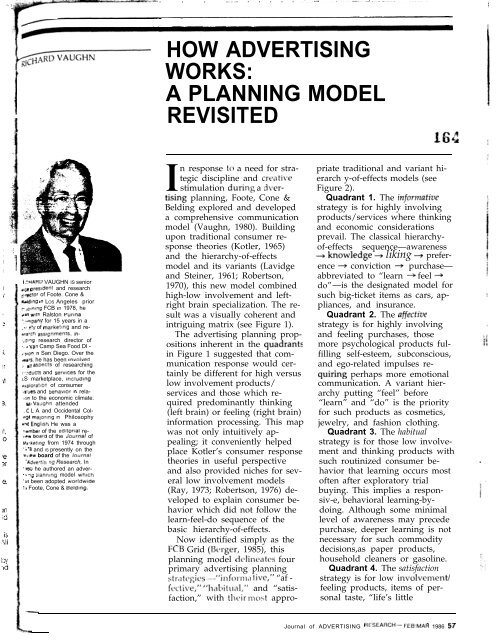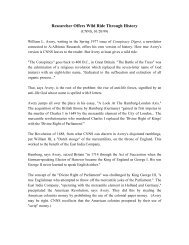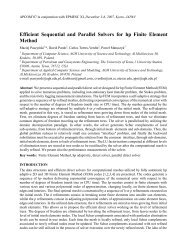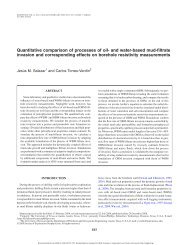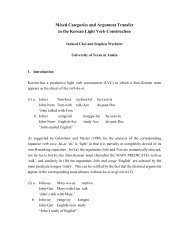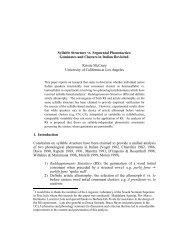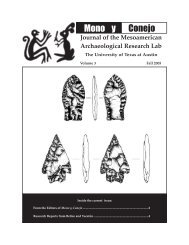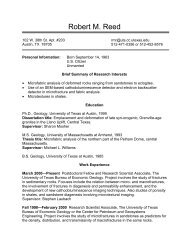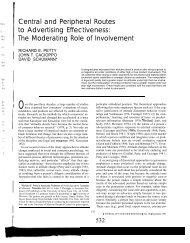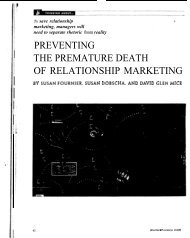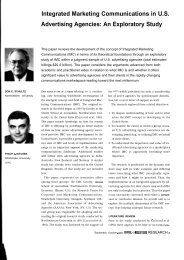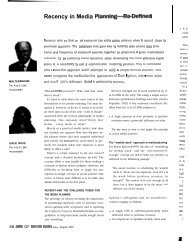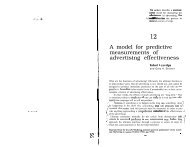HOW ADVERTISING WORKS: A PLANNING MODEL REVISITED
HOW ADVERTISING WORKS: A PLANNING MODEL REVISITED
HOW ADVERTISING WORKS: A PLANNING MODEL REVISITED
You also want an ePaper? Increase the reach of your titles
YUMPU automatically turns print PDFs into web optimized ePapers that Google loves.
,:.. c<br />
i :HARD VAUGHN IS senior<br />
~ presldf?~t and research<br />
!.Wtor of Foote. Cone &<br />
$ddlng In LOS Angeles prior<br />
- mmlng FCB In 1978, he<br />
kas w!th Ralston Purina<br />
:~pany for 15 years in a<br />
,, P:y of market!ng and re-<br />
~2rCFt asswments$ ln-<br />
.dlng research director of<br />
. * van Camp Sea Food DI -<br />
~wrr In San Diego. Over the<br />
rears, he has been tnvolved<br />
. ml! aspects of researching<br />
--?ducts and services for the<br />
.S marketplace, including<br />
PIoioratlon of consumer<br />
,@ues and behavior tn rela-<br />
‘t,xr to the economic climate.<br />
u, Vatighn attended<br />
. C L A and Occidental Col-<br />
~e majoring In Philosophy<br />
vw Engltsh He was a<br />
‘+?mber of the edltorlal re-<br />
NW board of the Journa/ of<br />
V$’ke?)ng from 1974 through<br />
‘:’8 and IS presently on the<br />
w.Iew board of the Journa/<br />
4<br />
hc/ve
Figure 1<br />
Tt+INK FEEL<br />
s<br />
o<br />
I<br />
HIGH<br />
:<br />
i<br />
INVOLVEMENT :<br />
D<br />
--------------- }-----”------”””<br />
:<br />
:<br />
I<br />
I<br />
:<br />
B<br />
:<br />
LOW<br />
I<br />
INVOLVEMENT D<br />
pleasures” such as beer, cigarettes,<br />
and candy. A social model<br />
is useful for many of these peeroriented<br />
items, and the hierarchy<br />
places “do” before “feel” and<br />
“learn” because product experience<br />
is so necessary a part of the<br />
communication process.<br />
Reaction to the grid was positive<br />
and enthusiastic. Despite, or<br />
perhaps because of, its simplicity<br />
manv advertisers accepted it as a<br />
prac~ical, creative way around the<br />
overutilization of the classical<br />
learn --+ feel -+ do hierarchy<br />
model in all advertising strategy<br />
planning. Even in its earliest applications,<br />
the grid:<br />
■ helped organize available research<br />
and management<br />
opinions about category and<br />
brand placement in consumer<br />
involvement and think-feel<br />
terms;<br />
● stimulated insightful questions<br />
and hypotheses about a<br />
product’s advertising options<br />
in the context of the competitive<br />
situation;<br />
■ and brought previously unconsidered<br />
ernot~onal, nonverbal,<br />
and sensory strategic possibilities<br />
into legitimate contention<br />
with rational, verbal, and semantically<br />
more powerful<br />
suggestions.<br />
Because the grid managed to<br />
condense almost three decades of<br />
con>umer behavior theory into a<br />
practical format, it worked sur-<br />
:<br />
t<br />
!<br />
prising]}’ well in a l’arit’t~’ of<br />
problen;-solving situati{}ns. It<br />
was even pointed out that the<br />
grid itself exemplified the unity<br />
of left-right brain con~plementarity<br />
in being bt)th ~’erbal and<br />
visual, thereb)’ ~’irtuall)’ c(lmpelling<br />
a ne~v w’a~’ of appn~aching<br />
str~tegic planning t(~r e~-c’n a<br />
long-establishcci product.<br />
It was also apparent, however,<br />
that some preliminary implications<br />
of the grid in several areas<br />
were premature if not unrealistic.<br />
For example, specific creative,<br />
media, and copy-test activities<br />
were proposed for each strategic<br />
quadrant before it was sensibly<br />
realized just how category or<br />
brand-specific such issues were,<br />
Also, think and feel were mistakenly<br />
viewed as independent<br />
rather than complementary and<br />
interrelated. One particularly<br />
flamboyant bit of generalization<br />
suggested that high involvement<br />
or think-oriented products would<br />
Figure 3<br />
58 Journal of <strong>ADVERTISING</strong> RESEARCH -- FEBIMAR 1986<br />
FCB U.S. Grid Study<br />
THINK<br />
D<br />
.Ufe<br />
lniwamO\2<br />
~ FarnIty -r<br />
. 35mm<br />
t4tQH<br />
carnera~<br />
INVOLVEMENT 8<br />
D8:<br />
B<br />
:. Ccwnphbf’i<br />
● M~CX oil : soap<br />
Figure 2<br />
FCB Grid “N K<br />
, ‘L<br />
WGH<br />
i<br />
INVOLVEMENT lNFORM&TIVE<br />
(Erxmomfc) , ! (p&&::&,<br />
\<br />
m---” - - - - - - - - - - ------. --=<br />
+<br />
-%<br />
:<br />
0<br />
n<br />
HAEtlTUAL : sAnsFAcTrQ<br />
(Respcmswe) , (social)<br />
LOW<br />
involvement m-Lwm-FIA ~ oo-l%l.bm<br />
naturally decay over time to 10M<br />
involvement or feel.<br />
These impractical hypothese5<br />
were abandoned during early,<br />
judgmental applications of th e<br />
grid, but two questions did<br />
emerge which could not be ignored<br />
with grid experience:<br />
(1) Did the grid accurately dep l<br />
real consumer involvement<br />
and think-feel dimensions?<br />
(2) Where were major product<br />
,<br />
● l%rfutna<br />
mstlng<br />
card<br />
:<br />
#.
Table 1<br />
FCB U.S. Grid Study—Factor Correlations<br />
Involvement Think/Feel<br />
Important .96 .03<br />
Lose .90 -.03<br />
Thought .97 .12<br />
Logical/objectwe .93 -.28<br />
Functional facts .75 -.50<br />
Feeling .70 .66<br />
Personality .47 .80<br />
Sensory effects -.47 .65<br />
categories actually located in<br />
grid space?<br />
The value of the grid in providing<br />
workable strategic solutions<br />
had been demonstrated in<br />
several advertising success<br />
stories, but FCB nevertheless undertook<br />
an extensive research<br />
and development program<br />
(Ratchford, 1985). A considerable<br />
effort went into operationalizing<br />
involvement and think-feel, and<br />
eventually eight scales were<br />
accepted:<br />
Involvement<br />
D Very important/unimportant<br />
decision<br />
■ Lot/little to lose if you choose<br />
the wrong brand<br />
m Decision requires ]ot/litt]e<br />
thought<br />
Think<br />
N Decision is/is not mairdy logical<br />
or objective<br />
s Decision is/is not based mainly<br />
on functional facts<br />
Feel<br />
Decision is/is not based on a lot<br />
of feeling<br />
Decision does/does not express<br />
one’s personality<br />
Decision is/is not based on<br />
looks, taste, touch, smell, or<br />
sound (sensory effects)<br />
The primary grid validation<br />
study was conducted in the<br />
United States among 1,800 con-<br />
60 Journal of <strong>ADVERTISING</strong> RESEARCH— FEB MAR 1986<br />
$<br />
sumers across some 250 prodUq<br />
categories. Respondents rated *Q<br />
cently purchased products/ ‘<br />
services using the eight scales,<br />
which permitted grid mapp~g<br />
on the basis of iIWO]VeIYK?nt ~d<br />
think-feel dimensionality. Te n<br />
representative categories are ~.<br />
lustrated in Figure 3.<br />
Products and services plotted<br />
where reasonably expected; ~i<br />
ysis of individual scale scores<br />
helped profile which constru~<br />
had contributed most to. categon<br />
location. And, as a quahty con-trol<br />
check on the test instru~eot<br />
the scales were correlated by<br />
Figure 4 ,“<br />
Headache Remedy—France<br />
HIGH<br />
INVOLVEMENT<br />
LOW<br />
INVOLVEMENT<br />
THINK<br />
D<br />
. Wganine :<br />
9<br />
D<br />
9<br />
iD<br />
FEEL<br />
16 ‘P’<br />
%$<br />
● TjMnol :<br />
“ Doliprane :<br />
● Efferalgan :<br />
Toutes marques $F “Aspegic<br />
As@nne.* ~p’(j :<br />
“UPSA :<br />
B<br />
-... - . . . . . . . . . . . . ..-.. *...= . . . . . ---------<br />
● Catalgme<br />
D<br />
&pinne du RhMe ~ BQBD<br />
i<br />
s D#<br />
B 9Bt<br />
- ——.— —.- —..-’<br />
/<br />
..=$
Figure 5<br />
Headache Remedy Clusters,<br />
Dispersion<br />
HIGH<br />
INVOLVEMENT<br />
FACIAL TISSUE<br />
CLUSTERS, DISPERSION<br />
THINK<br />
I<br />
I<br />
I<br />
I<br />
I<br />
11 111 111 1111111<br />
FEEL<br />
---- ---- ---- -.<br />
3 3=333 3333 3<br />
I<br />
3<br />
3 3 3 3 3 +3333X3333 3<br />
[<br />
3 333:3 3 3 3<br />
‘o’””’” /-%t’:z 33<br />
33<br />
i<br />
2 22 22 I 222<br />
I<br />
)<br />
2<br />
2<br />
( 2 2<br />
2<br />
2<br />
22 2<br />
2 2<br />
2 22<br />
Z42p22<br />
22;2 22<br />
q 2<br />
2 ’<br />
I<br />
2! 222 22<br />
2<br />
\<br />
m<br />
22A<br />
factor (see Table 1). Some think<br />
and feel items correlated with involvement,<br />
which confirmed that<br />
it was possible to have varying<br />
amounts of think and feel—high<br />
or low— depending on involvement.<br />
The involvement and<br />
think-feel factors, however,<br />
worked very well in discriminating<br />
consumers’ productdecision<br />
space.<br />
To date, over 20,000 consumer<br />
interviews have been completed<br />
in 23 countries. Correlations of<br />
62 Journal of ADVLR1 ISING RESEARCH— FEBIMAR 1986<br />
common products were con~puted<br />
between pairs of countries<br />
and were quite high, which told<br />
us that consumer mental processes<br />
were similar over the marketing<br />
world despite necessary<br />
concessions to communication<br />
distinctions in advertising.<br />
Previous judgmental use of the<br />
grid had included not only category<br />
plotting but exploratory<br />
placement of brands as well.<br />
Major grid studies provided large<br />
sample sizes for brand plotting,<br />
{<br />
106* #<br />
as shown in Figure 4 for aspirin<br />
brands.<br />
It was also practical and sti~u.<br />
lating to cluster consumers<br />
around a category plot. Ob-<br />
Viousl}’ not m’eryone placed eaCl,<br />
catego~ at the mean. A typical ‘<br />
three-cluster so]ution produced<br />
dispersions much like the example<br />
shown in FiSure 5. Exam.<br />
ining different invc;l~’en~ent and<br />
think/feel scores for these<br />
clusters, and their brand Prefer.<br />
ences, helped isolate new” stral<br />
tegic advertising options.<br />
. , 0 the<br />
grid managed to<br />
condense almost three<br />
decades of consumer behavim<br />
theory into a practical<br />
w<br />
fomat . . .<br />
And, in a follow7-up to the U.S.<br />
grid study, it m’as also possible tc<br />
plot characteristics for selected<br />
categories. Derived from prior<br />
research and brainstorming, cate<br />
gory and brand attributes were<br />
scaled for involvement and<br />
think-feel. As shown in Figure&<br />
the wine attributes that were<br />
most involving and feeling-oriented<br />
(upper right skew) were<br />
the most useful in differentiating<br />
consumer brand preferences.<br />
While brand and attribute<br />
mapping are far from unique,<br />
having such analysis anchored t(<br />
a strategic planning model is e~tremely<br />
useful in advertising de<br />
velopment. The linkage to consumer<br />
decision processes reassures<br />
that the executional option!<br />
are being created in a relevant<br />
context and that final advertising<br />
is more likely to be motivating<br />
Despite the successful applic~<br />
tion of the grid in planning advertising,<br />
we have nonetheless<br />
continued to speculate about thf<br />
involvement and think-feel dimensions.<br />
Fortunately, many<br />
-<br />
Y<br />
~<br />
1<br />
I<br />
I<br />
.<br />
Km
others are doing so as well. For<br />
example, while the FCB grid defines<br />
involvement in the context<br />
of a consumer’s purchase decision,<br />
it is clear that it could also<br />
be defined in the purchase situation<br />
or in product consumption<br />
(Kassa~ian, 1981).<br />
Since the grid is often used to<br />
reflect on previous consumer research<br />
as well as current marketing<br />
judgments about a<br />
product’s positioning and advertising<br />
opportunities, it is important<br />
to be flexible and insightful<br />
about consumer involvement.<br />
The real question often is not<br />
how much involvement but what<br />
kind and what it means. Recent<br />
projects by Laurent and Kapferer<br />
(1985) and Slama and Tashchian<br />
(1985) are promising in their exploration<br />
of an array of involvement<br />
elements.<br />
The think-feel dimension is<br />
more problematic. While splitbrain<br />
research supports specialized<br />
cognitive and affective<br />
mental styles, it is also recognized<br />
that the brain is actually a<br />
unified system (Levy, 1981) that<br />
integrates complex stimuli and<br />
adroitly manages both information<br />
and emotion. But most discussion<br />
of this topic in the marketing<br />
literature has been metaphorical<br />
rather than empirical.<br />
. . . consumer mental<br />
processes were similar over<br />
the marketing world despite<br />
necessary concessions to<br />
communication distinctions<br />
in advertising.<br />
Some advertising applications<br />
(H,msen, 1978; Appel, 1979;<br />
Kruglnan, 1980; Weinstein, 1982)<br />
sug~est that what we may be<br />
contending with, in its simplest<br />
comm u 11 i cation form, is a verbC~l/<br />
nonverbal and semantic/sensory<br />
Figure 6<br />
Wine for Dinner Parties-Attributes<br />
HIQH<br />
INVOLVEMEM<br />
1<br />
3<br />
INVOLVEMEW<br />
64 Journal of <strong>ADVERTISING</strong> RESEARCH— FEB’MAR 1986<br />
Wine For Dinner Parties<br />
THINK<br />
continuum that allows people to<br />
integrate information and emotion<br />
as necessary.<br />
Perhaps the best that can be<br />
said at this time is that emotion<br />
has at least become a legitimate<br />
topic for discussion in making effective<br />
advertisments (Zajonc,<br />
1982; Holbrook and O’Shaughnessy,<br />
1984; Stout and Leckenby,<br />
1984), and there is also renewed<br />
interest in nonverbal elements in<br />
advertising (Watson, 1979;<br />
Childers, 1984; Haley, 1984).<br />
While there is still much to be<br />
learned about thinking and<br />
feeling in advertising, the distinction<br />
made by Hollm-ook (1978)<br />
between “logical, objectively verifiable<br />
descriptions of tangible<br />
product features” and “emo-<br />
tional, subjective impressions of<br />
●<br />
●<br />
●<br />
●<br />
●<br />
2<br />
●<br />
●<br />
●<br />
●<br />
●<br />
anyohe confronting the uncertainties<br />
of advertising strategy<br />
and the perplexities of creative<br />
executions.<br />
Other work continues on the<br />
hierarchy-of-effects model<br />
(Preston and Thorson, 1984), be<br />
havior-oriented consumer<br />
learning models (Nerd, 1980;<br />
Rothschild, 1981), and attitudedominant<br />
(Mitchell, 1981; Shimf<br />
1981) consumer models to furthl<br />
our understanding of how advel<br />
tising works. Moran (1985) has<br />
put forth a computer microchip<br />
analogy with various consumer<br />
processing paths activated toward<br />
purchases much the way<br />
energy flows through a microci]<br />
cuit, clearing gates and followin<br />
channels set by consumer need!<br />
and advertising resportse.<br />
intangible aspects of tl~e product” Regardless of how these furare<br />
fundamentally important for ther explorations come out, thu<br />
— ——- . ..-. . .<br />
?-’-’-”<br />
~rce<br />
text 0<br />
tising<br />
We<br />
know<br />
tising<br />
work<br />
well f<br />
tive a<br />
~rovf<br />
~~mtil<br />
diligc<br />
}W’op
=$!<br />
‘er-<br />
‘gy<br />
tive<br />
the<br />
:), In<br />
o;<br />
~dehim<br />
furtl<br />
advi<br />
has<br />
chip<br />
mer<br />
tovay<br />
swi<br />
~wil<br />
lee d<br />
furtht<br />
,Jf the FCB Grid has helped to<br />
:ama~ through a previously rigid<br />
~ate~c barr!er and become<br />
~,lre expansive and creativ e in<br />
. .<br />
~e~oping advertising. It has<br />
~de strategic creative planning<br />
~Ore relevant m terms of poten-<br />
~[ consumer response and<br />
~mu]ated more exciting execu-<br />
~s. It has done so largely by<br />
~ning Up the advertising p]an-<br />
~rflg discussion to how adv er-<br />
~~in$ M’ork.s. Strategists have<br />
~mlated rational versus emotional<br />
~~pea]s, suggested involvement-<br />
~~lsing options, and considered<br />
~i~~’ing a brand in consumer<br />
~rception —all within the con-<br />
~Xt of a unified model of advertising<br />
effectiveness.<br />
if-e may not now, or ever,<br />
~~mi’ definitively how adverwing<br />
works. But we do know it<br />
wclrks in some definable ways<br />
%Ld enough to make more effective<br />
ad~’ertising. The FCB grid has<br />
proved useful in that effort and<br />
~{mtinues to grow in the hands of<br />
dhgent and inspired advertising<br />
pcop]e. D<br />
References<br />
tfppel, Valentine; Sidney Wein-<br />
~!~~in; and Curt Weinstein. “Brain<br />
4cti\’ity and Recall of TV Adverlt~ing.”<br />
Journal of Advertising Re-<br />
rger, David. “The FCB Grid. ”<br />
li~ l%vcwdi~lgs of the Adzwhking<br />
~%warch Fou ndotion 31st Annual<br />
~~i??lleyc}l~e, March 1985.<br />
Gilders, Terry L., and Michael J.<br />
~ !t)llstc)n. “Conditions for Pic-<br />
!llrc-Superiority Effect on Con-<br />
‘wner Memory. ” ]ournal of COrz-<br />
su ~llm Rcsmrch 11 (September<br />
1984): 643-653.<br />
Haley, Russell I.; Jack Richardson;<br />
and Beth M. Baldwin. “The<br />
Effects of Non-Verbal Communications<br />
in Television Advertising.”<br />
Journal of Advertising Rc-<br />
Sf?U?’Ch 24, 4 (1984): 11–18.<br />
Hansen, Fleming. “Hemispheral<br />
Lateralization: Implications for<br />
Understanding Consumer 13ehavior.”<br />
journal of CoIZsuIIIcr Research<br />
8 (June 1981): 23–36.<br />
Holbrook, Morris, B. “Be~~ond<br />
Attitude Structure Toward the<br />
Informational Determinants of<br />
Attitude.” Journal of Marketing<br />
Research 15 (1978): 545-556.<br />
Holbrook, Morris B., and John<br />
O’Shaughnessy. “The Role of<br />
Emotion in Advertising. ” Psycho~qyy<br />
& Mdwting 1, 2 (Summer<br />
1984): 45-64.<br />
Kassarjian, H. H. “Low Involvement—A<br />
Second Look. ” In Advances<br />
in Consumer Rewrch, Vol.<br />
8, K. B. Monroe, ed. Ann Arbor,<br />
MI: Association for Consumer<br />
Research, 1981.<br />
Kotler, Philip. “Behavioral<br />
Models for Analyzing Buyers. ”<br />
journal of Markcfing 29 (1965):<br />
37-45.<br />
Krugman, Herbert E. “Point of<br />
View: Sustained Viewing of Television.<br />
” Jourml of Advcrtisi?zCq Research<br />
20, 3 (1980): 65–68.<br />
Laurent, Gilles, and Jean-Noel<br />
Kapferer. “Measuring Consumer<br />
Involvement Profiles,” journal of<br />
Marketing Rwcarch 22, 1 (1985):<br />
41-53.<br />
Lavidge, R., and G. A. Steiner.<br />
“A Model For Predictive Measurements<br />
of Advertising Effectiveness.<br />
” Journol of Marketing 25<br />
(1961): 59-62.<br />
Levy, Jerre. “Children Think<br />
With Whole Brains: The Myth<br />
and Reality of Hemisphere Difference<br />
and Inter-hemispheric Integration.”<br />
Paper presented at<br />
the conference of The National Assmiotio]l<br />
of Secondmy School Principles,<br />
November 1981.<br />
Mitchell, Andrew A., and Jerry<br />
C. Olson. “Are Product Attribute<br />
Beliefs the Only Mediator of Advertising<br />
Effects of Brand Attitude?”<br />
]ournal of Morkctill


